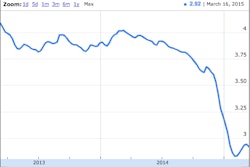 SmartDrive’s system uses a forward-facing camera and an in-cab camera.
SmartDrive’s system uses a forward-facing camera and an in-cab camera.Virtually all of SmartDrive System’s fleet customers are using both forward-facing and in-cab cameras in their trucks, said Steve Mitgang, SmartDrive CEO. He reviewed SmartDrive’s market during an interview in Orlando, Fla., at the annual meeting of the Truckload Carriers Association.
Most customers are initially resistant to the in-cab cameras because drivers typically resent the intrusion, Mitgang said. Once the value is fully explained, and in some cases a small group of drivers volunteers to test an in-cab camera, 99 percent of the customers see the value in a dual-cam system.
A lot of the value comes with the realization that about 80 percent of heavy-truck collisions with four-wheelers are not the fault of the truck driver, Mitgang said. Therefore in about 80 percent of accident cases with video evidence, the trucker is exonerated.
The driver acceptance works best when leadership communicates well, he said. “The fleet says we want you to be as safe as possible, and for you guys not to be wrongly accused,” which happens frequently, he said. “This thing’s going to save your bacon.”
Even in a case where a forward-facing camera clearly shows a four-wheeler being at fault, an aggressive plaintiff’s attorney can threaten to obtain a trucker’s cell phone records in the hope of finding evidence of distracted driving. Having complementary in-cab recording can help verify the trucker’s defense and head off an unwarranted settlement.
About half of SmartDrive’s customers choose to have the cameras running whenever the truck is in motion, Mitgang said. The other half has cameras triggered only by an event such as harsh braking or lane departure. With those that run on an “extended recording” mode, fleets do not use the extra material to troll for improper driver behavior, but rather to help reconstruct an incident beyond the parameters of the triggering event.




![Rick-Phillips,-Yokohama-Tire-Corporation[1]](https://img.ccjdigital.com/files/base/randallreilly/all/image/2015/03/ccj.Rick-Phillips-Yokohama-Tire-Corporation1.png?auto=format%2Ccompress&fit=crop&h=167&q=70&w=250)





